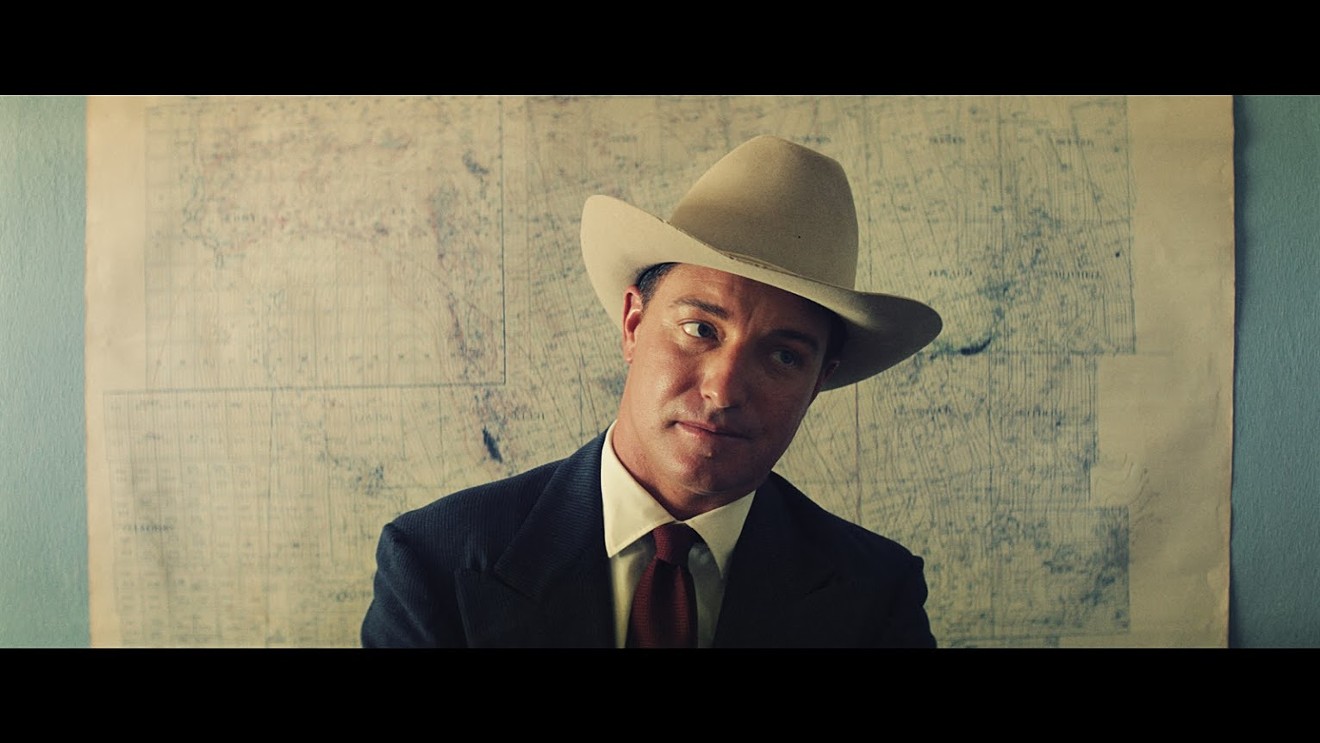They made a movie based on Tom Pendleton's acclaimed 1966 novel, The Iron Orchard, about an ambitious wildcatter seeking his fortune on the West Texas oil patch in the late 1930s. Some of the movie industry's most famous and influential filmmakers and stars tried and failed to bring it to the big screen. Roberts and Garrison made the film on a budget that would be a fraction of what a major movie studio would provide for such a project.
"When you start breaking it down on a level where Hollywood would normally approach this, you're talking about millions of dollars on sets and set pieces alone," Roberts says. "What we did is our film spans 15-17 years or something like that, and we took an approach where we broke it down scene by scene and how can we actually enlist the help of the oil industry to help us achieve these goals."
Most of the West Texas towns where they filmed, like Midland, did more than let them shoot at oil-drilling sites and pump stations. The communities where they filmed gave them access to hotels for the crew and let them shoot in their buildings so they could finally get the movie made.
After four years of hard work, Roberts' movie premiered Saturday during the Dallas International Film Festival. A second screening is scheduled for 5 p.m. Monday.
"It was a labor of love, and this is a Texas film through and through, and I know people talk about doing an opening at Cannes or opening at Sundance," Garrison says. "This is a perfect place to premiere this movie with the crew who busted their butt."
Roberts, a filmmaker who directed short films and a few features, including an adaptation of vodka maker Tito Beveridge's play This Side of the Dirt, first learned about the project in 2009 while living in South America. He says his father, who worked as an oil man just like the book's title character, met the person with the film rights to Pendleton's book.
"My old man sold me on talking to him and knew him, and it didn't take much, but I reached out him," Roberts says. "He was this good
Roberts wasn't the first filmmaker to struggle to get The Iron Orchard onto the big screen. Pendleton's book was published to wide acclaim and eventually attracted the interest of Hollywood filmmakers and stars such as Robert Redford, Paul Newman, Clint Eastwood and Tommy Lee Jones. Garrison, a Richardson native who first found fame as the master pickpocket Tweener on the first season of the Fox drama Prison Break, says he even heard in some Hollywood circles that director Ron Howard once tried to
When Roberts returned to Texas in 2010, he learned that the man who wanted to make the movie had a change of heart. So Roberts bought the rights from him and asked for his blessing to make the movie on his own. He tapped screenwriter Gerry De Leon, who worked with Roberts as a script consultant on This Side of the Dirt, to pen the screenplay, and the pair went through 20 revisions over a two-year period before pursuing funding for the project."We decided to do it down and gritty, indie-style. It doesn't matter if famous people were in it or not. Let's just do a real authentic story of a West Texas wild town." – Ty Roberts
tweet this
Roberts says he struggled for years to raise the funds or attract the attention of a studio before deciding to make it an independent production.
"We decided to do it down and gritty, indie-style," Roberts says. "It doesn't matter if famous people were in it or not. Let's just do a real authentic story of a West Texas wild town."
In 2015, he cast Garrison in the lead role. Roberts says Garrison made an ideal fit for the role and helped grease the wheels of the production with his presence.
"Lane really helped us stay on track and focused because he's very enthusiastic," Roberts says. "He's a contagious person on that level. He's kind of a no B.S. kind of guy and spent probably 15 years in Hollywood, and we learned a lot. He helped us strategize about this and how to get other actors involved."
Garrison says he relished the chance to play McNeely for the challenge of playing a larger-than-life character.
"It's the role of a lifetime for me," Garrison says. "I told Ty the other day, it doesn't get better than this. It's a period piece where I could [play] the full arc of a man's life, and I cover everything along the way emotionally. It just doesn't get better as an actor, and it was, by far, the hardest work of my life.
"It's not just the heat and hard work. It's the span of a life, and you don't do it in chronological order. So it's like doing a one-man show."
He also spent part of his childhood on an oil rig with his father, who worked on one for a summer while doing a run of odd jobs.
"For me, it laid the groundwork because I remember those trips as a kid so vividly that I knew what I was getting into, so I knew I was kind of gearing up to go into battle," Garrison says. "What I did was before shooting even started, I was there a month before any other actor came so I could adapt and be in the environment. I would go on rigs out there, and I was glad I did so I could acclimate myself to the heat."
The book tells McNeely's story from his humble beginnings as a high school dropout who finds work in the oil fields to his rise through the Texas oil empire. His ambition for love gets caught up with his rise to the top when an old socialite flame re-enters his life after he becomes a wealthy industry icon.
"Even though it's a period piece, it's still that coming-of-age, life-lesson-learned kind of story," Garrison says. "A guy who's penniless and broke strikes oil and becomes insanely wealthy and loses sight of what's most important in life. It's not like we haven't had a story like this before, but it's a different side of it and a different way to tell it and constantly reminds ourselves for our own lives that we can get caught up and think it has to be
Some of the book's crucial scenes required expensive set designs and special effects such as oil strikes and explosions. The filmmakers made deals with some of the rigs in the West Texas oil fields to set up scenes that would take audiences to the 1940s. Roberts says they even found an authentic Kelly drive oil rig just like the one Pendleton describes in his novel.
"Honestly, no bullshit," Roberts says. "We couldn't have done this at this budget and the scope of this film without these community members coming out and getting excited with us and opening their doors. It would have been impossible with our budget to do this. That, to me, speaks volumes about Texas and the people who like this sort of industry, and like it or not, this industry has made this state a pretty dominant player in the world market, and it's an indicator for the entire U.S. economy."
The result is a film "that looks like a $20 million film," but Roberts says it cost much less and still manages to tell an important, heart-wrenching story about the nature of success in the economic backbone of Texas history.
"I think that the movie is beautiful, and













